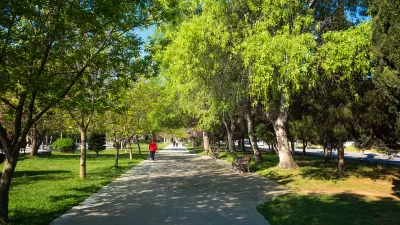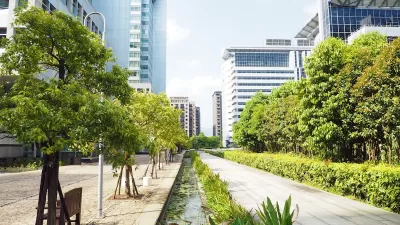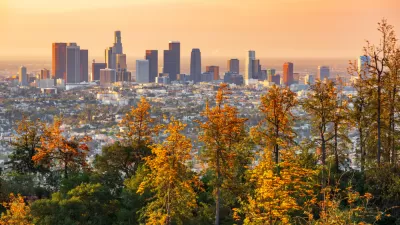A new tool can help cities understand the benefits of tree planting efforts at the municipal scale.

A new study from researchers from the Chinese Academy of Sciences and the Cary Institute of Urban Ecosystem Studies offers a way to understand the benefits of urban trees at larger scales so they can make more informed decisions about tree planting programs aimed at reducing urban temperatures and improving air quality.
“Overall, the team discovered that the cooling efficiency of urban trees increased at larger scales,” in part thanks to the ability to plant larger groups of trees. “For example, the authors estimate that the city of Baltimore could reduce land surface temperatures by 0.23°C if they increased tree canopy by 1%. To achieve 1.5°C of cooling, they would need to increase tree canopy cover by 6.39%.”
With greater clarity about the relationships between area, tree canopy cover, and cooling effects, the paper makes it possible to predict cooling effects at the whole-city scale, offering a valuable tool for managers to set urban tree canopy goals to reduce extreme heat.
One of the study’s authors points out that while the paper can provide useful data for city-level decision-making, planners should be careful to ensure equity and community buy-in at the neighborhood scale.
FULL STORY: How many trees does it take to cool a city? Researchers develop tool to set urban tree canopy goals

Manufactured Crisis: Losing the Nation’s Largest Source of Unsubsidized Affordable Housing
Manufactured housing communities have long been an affordable housing option for millions of people living in the U.S., but that affordability is disappearing rapidly. How did we get here?

Americans May Be Stuck — But Why?
Americans are moving a lot less than they once did, and that is a problem. While Yoni Applebaum, in his highly-publicized article Stuck, gets the reasons badly wrong, it's still important to ask: why are we moving so much less than before?

Research Shows More Roads = More Driving
A national study shows, once again, that increasing road supply induces additional vehicle travel, particularly over the long run.

Judge Halts Enforcement of Anti-Homeless Laws in Grants Pass
The Oregon city will be barred from enforcing two ordinances that prosecute unhoused residents until it increases capacity and accessibility at designated camping sites.

Advancing Sustainability in Los Angeles County Schools
The Los Angeles County Office of Education’s Green Schools Symposium brings together educators, students, and experts to advance sustainability in schools through innovative design, climate resilience strategies, and collaborative learning.

Using Old Oil and Gas Wells for Green Energy Storage
Penn State researchers have found that repurposing abandoned oil and gas wells for geothermal-assisted compressed-air energy storage can boost efficiency, reduce environmental risks, and support clean energy and job transitions.
Urban Design for Planners 1: Software Tools
This six-course series explores essential urban design concepts using open source software and equips planners with the tools they need to participate fully in the urban design process.
Planning for Universal Design
Learn the tools for implementing Universal Design in planning regulations.
City of Moreno Valley
Institute for Housing and Urban Development Studies (IHS)
City of Grandview
Harvard GSD Executive Education
NYU Wagner Graduate School of Public Service
City of Cambridge, Maryland
Newport County Development Council: Connect Greater Newport





























